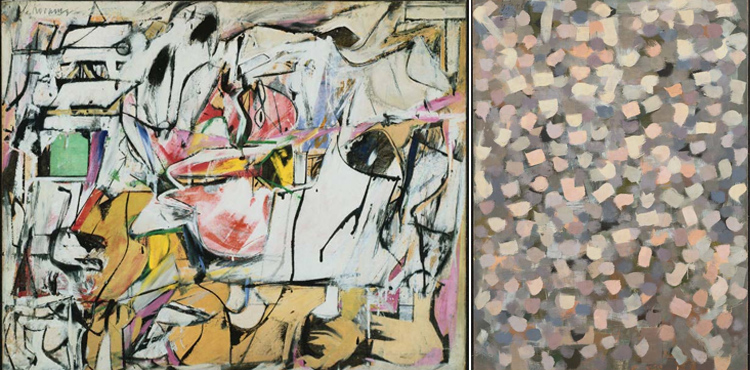Phillips Publicity and Marketing Coordinator Amy Wike asked Lana Housholder, Gallery Educator and tour guide to D.C. Emerging Museum Professionals Slow Art Day 2013 tour on April 27, some questions about the experience. Read the tour organizer’s account here. In the spirit of slow looking, we’ve reproduced the works below to invite further contemplation.

(left) Willem de Kooning, Asheville, ca. 1935. Oil and enamel on cardboard, 25 9/16 x 31 7/8 in. The Phillips Collection, Washington, D.C. Acquired 1952 (right) Bradley Walker Tomlin, No. 8, 1952. Oil and charcoal on canvas, 65 7/8 x 47 7/8 in. The Phillips Collection, Washington, D.C. Acquired 1955.
Amy Wike: What were some of the things Slow Art Day 2013 participants focused on during the tour?
Lana Housholder: I asked the participants lots of questions, such as: What object or shape did you first notice when looking at this work of art? Why do you think that was the first think you noticed? Do you see movement in this work of art, or does it seem still? Do the colors, lines, and shapes make it seem that way? How? What is the story that you see happening in this work of art? Who are the characters in this story? How many characters are present in this scene? Where is this taking place? What emotions seem to be expressed in the story? What do you see that makes you say that? What’s one word you might use to describe the mood of this painting? What’s one word you could use to describe the subject of this painting?
AW: Did you notice any interesting interpretations from visitors?
LH: Yes. The visitors found objects and shapes in several abstract works of art that I hadn’t seen before. They explained to me why those objects were the first thing they noticed and what drew their eye to them. Visitors also explained to me how certain works would appear differently if they were a different size. For example, Willem de Kooning’s Asheville would feel much more chaotic and full of movement and intensity if it were larger. It is a relatively small piece in comparison to his other works. This makes the work feel more intimate and less busy, they said.
AW: As tour guide, do you have any additional observations about the experience?
LH: I really enjoyed the experience overall. I loved hearing the thoughts of the visitors and focusing on their interpretations of the art. It was nice that the audience understood the focus of the tour was on the interpretation and act of looking as well as the history surrounding the art and artist. Oftentimes I feel that visitors expect me to give a lecture when in front of a work of art. They want to know content. It was nice to not have that be the only expectation. As Gallery Educators in the Education Department at the Phillips, we are trained to have looking exercises be part of each museum tour. We ask several looking questions at each work of art to get the audience involved in the act of really seeing a piece instead of passively listening to the Gallery Educator. We hope our tours focus on both the content surrounding the art as well as an audience-led interpretation of what is on view.
